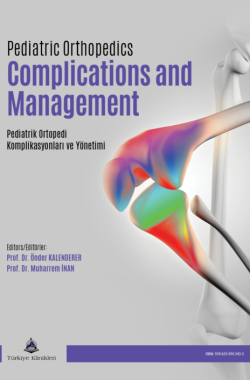Trauma: Compartments
Aybegüm BALCIa , Halil İbrahim AÇARa
aAnkara University Faculty of Medicine, Department of Anatomy, Ankara, Türkiye
Balcı A, Açar Hİ. Trauma: Compartments. In: Kalenderer Ö, İnan M, eds. Pediatric Orthopedics Complications and Management. 1st ed. Ankara: Türkiye Klinikleri; 2024. p.7-18.
ABSTRACT
The compartment is a section surrounded by connective tissue layers and bones in the body, and it contains muscles, vessels, and nerves. Because of inelastic fascial boundaries, any acute or chronic condition can lead to increasing pressure into compartments and compartment syndrome may occur. In the lower extremities, especially in the legs, the fascias are stronger and tighter and the compartments are narrower. Because of this, compartment syndrome occurs most often in the leg. There are three main compartments within the leg. These are called anterior, posterior and lateral compartments. The posterior compartment also divides superficial and deep portions via the transverse intermuscular septum. The anterior compartment of the leg is the most prone to compartment syndrome in the lower limb. Knowledge of the fascial structures that limit the compartments and the anatomical structures within them is vital for treatment of compartment syndrome.
Keywords: Compartment syndromes; anatomy; extremities; myofascial release therapy
Kaynak Göster
Referanslar
- Patel RV, Haddad FS. Compartment syndromes. Br J Hosp Med (Lond). 2005;66(10):583-6. [Crossref] [PubMed]
- Williams S, Chen S, Todd NW. Compartment Syndrome in the Foot and Leg. Clin Podiatr Med Surg. 2023;40(1):1-21. [Crossref] [PubMed]
- Leversedge FJ, Moore TJ, Peterson BC, Seiler JG 3rd. Compartment syndrome of the upper extremity. J Hand Surg Am. 2011;36(3):544-59; quiz 560. [Crossref] [PubMed]
- Fleming P, Lenehan B, Sankar R, Folan-Curran J, Curtin W. One-third, two-thirds: relationship of the radial nerve to the lateral intermuscular septum in the arm. Clin Anat. 2004;17(1):26-9. [Crossref] [PubMed]
- Kistler JM, Ilyas AM, Thoder JJ. Forearm Compartment Syndrome: Evaluation and Management. Hand Clin. 2018;34(1):53-60. [Crossref] [PubMed]
- Oak NR, Abrams RA. Compartment Syndrome of the Hand. Orthop Clin North Am. 2016;47(3):609-16. [Crossref] [PubMed]
- Rubinstein AJ, Ahmed IH, Vosbikian MM. Hand Compartment Syndrome. Hand Clin. 2018;34(1):41-52. [Crossref] [PubMed]
- Shoja MM. Chapter 80: Pelvic girdle, gluteal region and thigh. In: Standring S, ed. Gray's Anatomy, The Anatomical Basis of Clinical Practice. 42nd ed. Amsterdam: Elsevier; 2020. p.1337-75.
- Spinner RJ, Howe BM. Chapter 83: Leg. In: Standring S, ed. Gray's Anatomy, The Anatomical Basis of Clinical Practice. 42nd ed. Amsterdam: Elsevier; 2020. p.1400-17.
- Rourke K, Dafydd H, Parkin IG. Fibularis tertius: revisiting the anatomy. Clin Anat. 2007;20(8):946-9. [Crossref] [PubMed]
- Lambert HW, Atsas S. An anterior fibulocalcaneus muscle: An anomalous muscle discovered in the anterior compartment of the leg. Clin Anat. 2010;23(8):911-4. [Crossref] [PubMed]
- Wakahara T, Takeshita K, Kato E, Miyatani M, Tanaka NI, Kanehisa H, et al. Variability of limb muscle size in young men. Am J Hum Biol. 2010;22(1):55-9. [Crossref] [PubMed]
- Bao B, Wei H, Zhu H, Zheng X. Transfer of Soleus Muscular Branch of Tibial Nerve to Deep Fibular Nerve to Repair Foot Drop After Common Peroneal Nerve Injury: A Retrospective Study. Front Neurol. 2022;13:745746. [Crossref] [PubMed] [PMC]
- Diner C, Mathieu L, Pfister G, Mourtialon R, Denormandie P, de L Escalopier N. Nerve transfer in the spastic equino varus foot: Anatomical feasibility study. Foot Ankle Surg. 2023;29(4):346-9. [Crossref] [PubMed]
- Carolus AE, Becker M, Cuny J, Smektala R, Schmieder K, Brenke C. The Interdisciplinary Management of Foot Drop. Dtsch Arztebl Int. 2019;116(20):347-354. [Crossref]
- Kil SW, Jung GS. Anatomical variations of the popliteal artery and its tibial branches: analysis in 1242 extremities. Cardiovasc Intervent Radiol. 2009;32(2):233-40. [Crossref] [PubMed]
- Olewnik Ł, Łabętowicz P, Podgórski M, Polguj M, Ruzik K, Topol M. Variations in terminal branches of the popliteal artery: cadaveric study. Surg Radiol Anat. 2019;41(12):1473-82. [Crossref] [PubMed] [PMC]
- Olewnik Ł, Podgórski M, Ruzik K, Polguj M, Topol M. New classification of the distal attachment of the fibularis brevis - Anatomical variations and potential clinical implications. Foot Ankle Surg. 2020;26(3):308-13. [Crossref] [PubMed]
- Cheney RA, Melaragno PG, Prayson MJ, Bennett GL, Njus GO. Anatomic investigation of the deep posterior compartment of the leg. Foot Ankle Int. 1998;19(2):98-101. [Crossref] [PubMed]
- Nayak SB, Shetty SD. Two accessory muscles of leg: potential source of entrapment of posterior tibial vessels. Surg Radiol Anat. 2019;41(1):97-9. [Crossref] [PubMed]
- Sekiya S, Kumaki K, Yamada TK, Horiguchi M. Nerve supply to the accessory soleus muscle. Acta Anat (Basel). 1994;149(2):121-7. [Crossref] [PubMed]
- Holzmann M, Almudallal N, Rohlck K, Singh R, Lee S, Fredieu J. Identification of a flexor digitorum accessorius longus muscle with unique distal attachments. Foot (Edinb). 2009;19(4):224-6. [Crossref] [PubMed]
- Faymonville C, Andermahr J, Seidel U, Müller LP, Skouras E, Eysel P, et al. Compartments of the foot: topographic anatomy. Surg Radiol Anat. 2012;34(10):929-33. [Crossref] [PubMed]
- Kamel R, Sakla FB. Anatomical compartments of the sole of the human foot. Anat Rec. 1961;140:57-60. [Crossref] [PubMed]
- Goodwin DW, Salonen DC, Yu JS, Brossmann J, Trudell DJ, Resnick DL. Plantar compartments of the foot: MR appearance in cadavers and diabetic patients. Radiology. 1995;196(3):623-30. [Crossref] [PubMed]
- Ling ZX, Kumar VP. The myofascial compartments of the foot: a cadaver study. J Bone Joint Surg Br. 2008;90(8):1114-8. [Crossref] [PubMed]
- Dodd A, Le I. Foot compartment syndrome: diagnosis and management. J Am Acad Orthop Surg. 2013;21(11):657-64. [Crossref] [PubMed]

